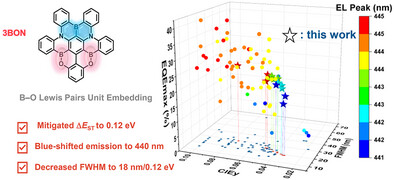
近日,深圳大学杨楚罗团队研究了用于高性能BT.2020深蓝色OLED的硼-氧Lewis对集成多谐振热激活延迟荧光发射器。这一研究成果发表在2025年10月8日出版的《德国应用化学》杂志上。
对满足严格的BT.2020颜色标准的深蓝色发射体的追求——需要理想的峰值、窄的半峰全宽(FWHM)和最小的单重态-三重态能量分裂(ΔEST)——往往受到多共振热激活延迟荧光(MR-TADF)分子复杂合成的阻碍。研究组引入了一种新的选择性策略:通过分子内亲电硼化将B-O-Lewis对结合到MR-TADF系统中。通过仔细控制串联的bora-Friedel-Crafts反应,合成了鞍形分子3BON,尽管环状硼结构对逆bora-Friedel-Crafts反应具有典型的脆弱性。3BON表现出高效的深蓝色TADF发射,峰值位于440 nm,半峰全宽为18 nm,ΔEST低至0.12 eV。
与母发射极相比,DABNA-1、3BON实现了同时的蓝移、变窄的半峰全宽和减小的ΔEST。主相互作用轨道(PIO)分析表明,涉及B-O-Lewis对的独特轨道相互作用使能级不稳定,导致蓝移发射。采用3BON的有机发光二极管(OLED)展现出了最先进的性能。该器件实现了24.8%(9 wt.%)的最大外部量子效率(EQEmax),具有超深蓝色窄带发射(443 nm峰值,24 nm半峰全宽;CIE:0.1554,0.0454),完全满足BT.2020标准。
此外,3BON独特的鞍形结构赋予了其卓越的掺杂耐受性,EQEmax在0.520 wt.%的宽掺杂范围内攀升至26.3%。超荧光(HF)器件也显示出优异的性能(EQEmax=23.8%,441 nm峰值,19 nm半峰全宽)。这些结果代表了迄今为止报告的最佳BT.2020兼容OLED性能之一。
附:英文原文
Title: Boron–Oxygen Lewis Pairs Integrated Multi-Resonant Thermally Activated Delayed Fluorescence Emitter for High-Performance BT.2020 Deep-Blue OLEDs
Author: Chen Cao, Ze-Lin Zhu, Si-Jie Xian, Jingsheng Miao, Si-Yuan He, Hong-Ji Tan, Mingxin Xing, He Liu, Ming Yang, Tao Hua, Wentao Xie, Chuluo Yang
Issue&Volume: 2025-10-08
Abstract: The quest for deep-blue emitters meeting the stringent BT.2020 color standard—requiring an ideal peak, narrow full-width-at-half-maximum (FWHM), and minimal singlet-triplet energy splitting (ΔEST)—is often hampered by the complex synthesis of multi-resonant thermally activated delayed fluorescence (MR-TADF) molecules. This work introduces a novel, selective strategy: incorporating B–O Lewis pairs into an MR-TADF system via intramolecular electrophilic borylation. By carefully controlling a tandem bora-Friedel–Crafts reaction, we synthesized the saddle-shaped molecule 3BON, despite the typical vulnerability of annulated boron structures to retro-bora-Friedel–Crafts reactions. 3BON exhibits highly efficient deep-blue TADF emission, with a peak at 440 nm, a narrow FWHM of 18 nm, and a low ΔEST of 0.12 eV. Compared to its parent emitter, DABNA-1, 3BON achieves a simultaneous blue-shift, narrowed FWHM, and reduced ΔEST. Principal Interacting Orbital (PIO) analysis indicates that unique orbital interactions involving the B–O Lewis pairs destabilize energy levels, causing the blue-shifted emission. Organic light-emitting diodes (OLEDs) utilizing 3BON demonstrated state-of-the-art performance. The device achieves a maximum external quantum efficiency (EQEmax) of 24.8% (at 9 wt.%) with ultra-deep blue narrowband emission (443 nm peak, 24 nm FWHM; CIE: 0.1554, 0.0454), fully satisfying the BT.2020 standard. Furthermore, 3BON's unique saddle-shaped architecture imparts remarkable doping tolerance, with EQEmax climbing up to 26.3% across a wide 0.520 wt.% doping range. A hyperfluorescent (HF) device also showed excellent performance (EQEmax = 23.8%, 441 nm peak, 19 nm FWHM). These results represent one of the best BT.2020-compliant OLED performances reported to date.
DOI: 10.1002/anie.202518651
Source: https://onlinelibrary.wiley.com/doi/10.1002/anie.202518651
Angewandte Chemie:《德国应用化学》,创刊于1887年。隶属于德国化学会,最新IF:16.823
官方网址:https://onlinelibrary.wiley.com/journal/15213773
投稿链接:https://www.editorialmanager.com/anie/default.aspx
